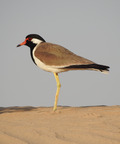- Record: found
- Abstract: found
- Article: found
Diel timing of nest predation changes across breeding season in a subtropical shorebird

Read this article at
Abstract
Predation is the most common cause of nest failure in birds. While nest predation is relatively well studied in general, our knowledge is unevenly distributed across the globe and taxa, with, for example, limited information on shorebirds breeding in subtropics. Importantly, we know fairly little about the timing of predation within a day. Here, we followed 444 nests of the red‐wattled lapwing ( Vanellus indicus), a ground‐nesting shorebird, for a sum of 7,828 days to estimate a nest predation rate, and continuously monitored 230 of these nests for a sum of 2,779 days to reveal how the timing of predation changes over the day and season in a subtropical desert. We found that 312 nests (70%) hatched, 76 nests (17%) were predated, 23 (5%) failed for other reasons, and 33 (7%) had an unknown fate. Daily predation rate was 0.95% (95%CrI: 0.76% – 1.19%), which for a 30‐day long incubation period translates into ~25% (20% – 30%) chance of nest being predated. Such a predation rate is low compared to most other avian species. Predation events ( N = 25) were evenly distributed across day and night, with a tendency for increased predation around sunrise, and evenly distributed also across the season, although night predation was more common later in the season, perhaps because predators reduce their activity during daylight to avoid extreme heat. Indeed, nests were never predated when midday ground temperatures exceeded 45℃. Whether the diel activity pattern of resident predators undeniably changes across the breeding season and whether the described predation patterns hold for other populations, species, and geographical regions await future investigations.
Abstract
The diel timing of nest predation in birds is mostly unknown. Here, incubating red‐wattled lapwings faced a low chance of nest predation (20%–30%), but night predation was more common later in the season, perhaps because predators reduce their activity during daylight to avoid extreme heat. Indeed, nests were never predated when midday ground temperatures exceeded 45℃. These results highlight the need for continuous monitoring to reveal the temporal pattern of predation on multiple time scales.
Related collections
Most cited references96
- Record: found
- Abstract: not found
- Article: not found
Robustness of linear mixed‐effects models to violations of distributional assumptions
- Record: found
- Abstract: found
- Article: not found
Nest predation increases with parental activity: separating nest site and parental activity effects.
- Record: found
- Abstract: not found
- Article: not found
